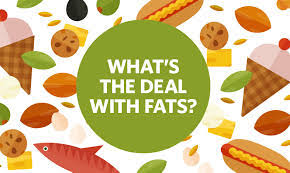In today’s world, fats are considered as the most evil part in our diets and are the most looked down upon. If we cut down on the fats and the fatty foods from our diet are we or are we not compromising on our health? Read on to get your facts straight…
HOW GOOD ARE FATS? 
Fats are an essential part of our body, accounting for one fifth to one-sixth of our body weight. Fats are required for hormone production; they facilitate oxygen transport and also nourish the skin and mucous membranes. The cells and tissues of our body have fat as an integral part. The vital organs like heart, brain and liver, are protected by a sheath of fat and water that holds them in place and prevents injury. The nerves are also protected by fat. A layer of fat beneath the skin helps to conserve body heat and regulate body temperature, thus acting as insulation against cold. The fat around the joints acts as a lubricant and allows us to move these smoothly. Without fat in our bodies, we would die instantly. Our cell membranes and nervous system would collapse.
Fats increase the flavor, palatability, and satiety value of foods. The slower rate of digestion of fat as compared to carbohydrates results in a feeling of satisfaction. Besides providing energy, oils and fats have several functions in the body. Food fats also aid the transport and absorption of fat-soluble vitamins such as A, D, E, and K.
The fat in your diet is made up of four different types: Saturated fatty acids (SFA), Polyunsaturated fatty acids (PUFA), monounsaturated fatty acids (MUFA), and Omega 3 fats (a special type of polyunsaturated fat). You need the proper amount of each family of fat because each affects your health and risk of disease in different ways.
[table id=2 /]
TO SUM IT ALL… PUFAs are an essential ingredient for good health. At least 2-3 teaspoons or 2 to 3 servings of fish should be coming from this fat in a day’s diet for an adult. Approximately one-third of your total dietary fat should consist of monounsaturated fats.
Artificially saturated fats or Trans fatty acids are now considered totally evil. These are the kind you find in processed and junk food or in deep-fried foods.
HOW MUCH FAT IS ENOUGH AND HOW TO BALANCE YOUR FATS? Although the different types of fat have a varied–and admittedly confusing–effect on health and disease, the basic message is simple: LIMIT THE BAD FATS AND REPLACE THEM WITH GOOD FATS.
Omega-3s are one of your best friends, not just for fat burning but also for overall health. These essential fats clear up dry skin, stimulate your metabolism, boost brain function, protect your heart and strengthen your immune system.
Ideally, you can get as much as 20 to 25 percent of your total calories from fat. Just as a diet too heavy on carbohydrates can be deleterious to the health, so can one too high in proteins or too high in fats.
BALANCE IS THE RIGHT KEY.

